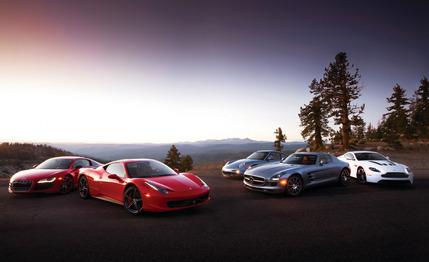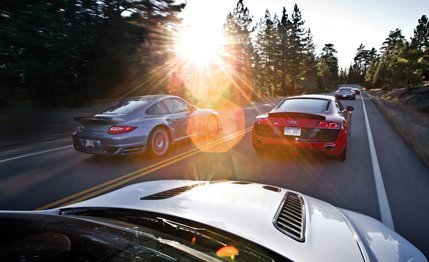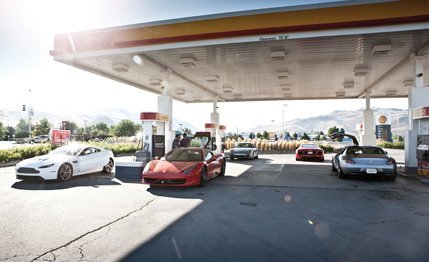
 Comparison Tests
Comparison Tests


How fast is fast? How fast is fast enough? Perceptions vary. You might observe, correctly, that this five-rocket salvo doesn’t represent the ultimate liquid-fuel thrust available on today’s automotive launchpad. There are cars—a few—with higher power ratings, higher flat-out speeds, and much higher price tags.
Compared with a Bugatti Veyron, the ultimate example, everything in this collection looks a little more ordinary and a lot more attainable. You could buy the entire group and still have a couple hundred thou left over. But it’s hard to argue that these aren’t some of the most desirable cars on the road. They make us even more grateful than usual that we aren’t quadrupeds. The slowest sprints to 60 in barely more than four seconds, and all can attain 100 mph in less than 10 seconds.
We’d hoped to make this show a little bigger, but the folks at Lamborghini declined to participate. Disappointing. But even with a Lambo in the cast, the star of this show, in terms of sheer wattage, has to be Ferrari’s new 458 Italia. The menacingly wedgy sheetmetal, amplified by the baritone boom of its 4.5-liter V-8, sends parking valets into fibrillating sensory overload.
The Mercedes SLS AMG also got a lot of attention whenever we popped its gullwing doors, a move that could draw a crowd in Antarctica.
This is not to suggest that the other contestants are wallflowers. All three—Aston Martin Vantage, Audi R8, Porsche 911 Turbo—are familiar faces [“Everyday Supercars,” July 2007]. But “familiar” does not mean “same as.”
The Aston checks in with the DBS’s 5.9-liter V-12. Similarly, the R8 5.2 has a V-10 to increase its urgency index. And the 911 Turbo, a sports-car benchmark for more than four decades, emerged from its recent makeover faster (of course) and easier to manage at high speed on challenging roads. The example we have here is the 30-hp-boosted Turbo S version.


We opened the comparo at Nevada’s Reno-Fernley Raceway, in the bleak desert hills about 30 miles east of Reno. That’s where we generated our test numbers, and these merit a couple caveats. Like most desert tracks, Reno-Fernley is dusty, which likely diluted both launch and braking performance a bit. Also, the skidpad’s unswept surface, bumpy paving, and tight radius (180 feet) diminished lateral-acceleration results.
We drove west from Reno-Fernley, to sparsely populated roads in the Sierra Nevada. The High Sierra experience—unknown public two-lanes, sometimes requiring extraordinary responses—revealed behavioral traits and capabilities that the racetrack could not.


Extraordinary, of course, is what these machines are. But inevitably, some emerged as more extraordinary than others.